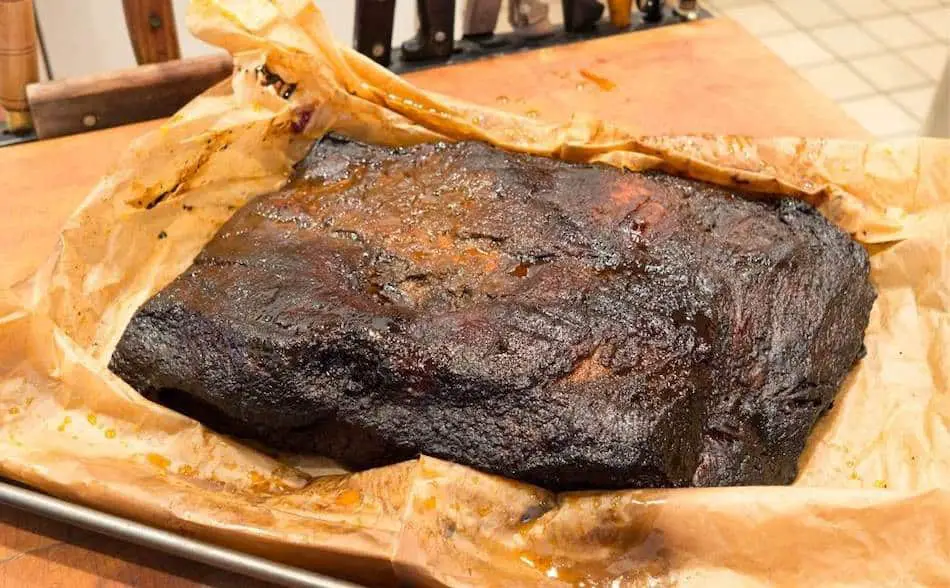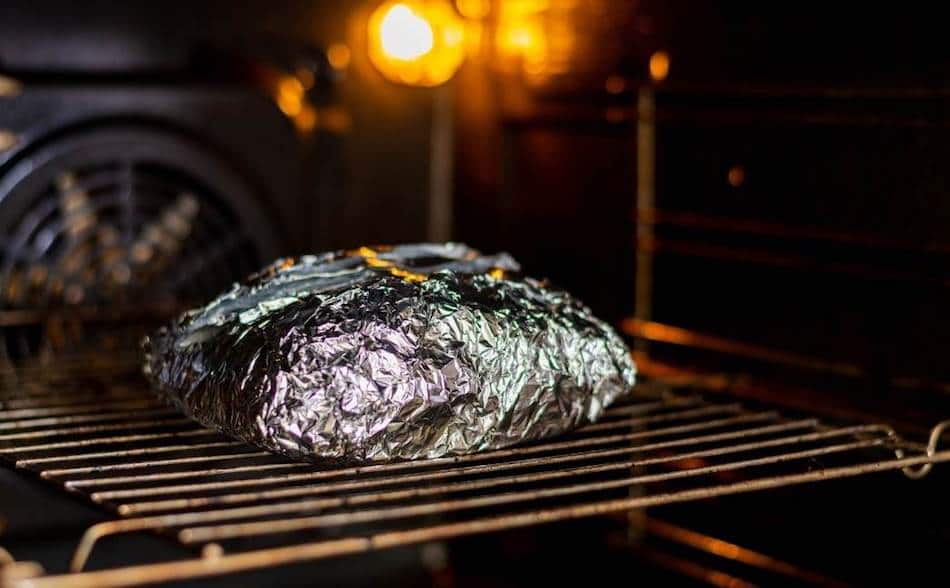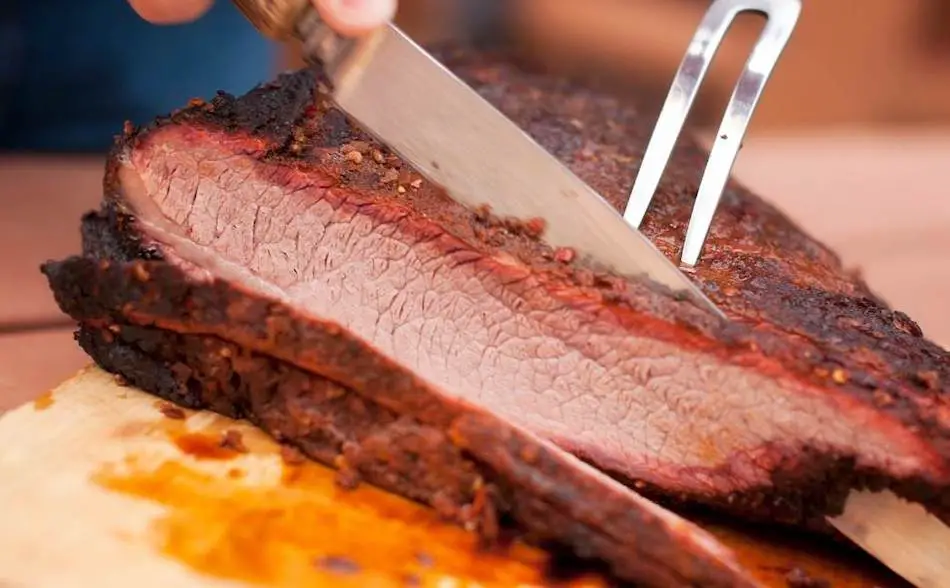
Once brisket has been removed from the smoker, resting or holding the brisket is the last stage of the cooking process. This is a crucial step and can make or break your brisket, so I wanted to find out everything I could about resting brisket. Meat will continue to cook long after it has been removed from the smoker.
Brisket should be rested for at least 30 minutes prior to slicing, but 1 hour is preferable. While resting, leave the brisket wrapped, but vent one corner. To hold the brisket, wrap the meat in a towel, then placed in an insulated dry cooler for up to 4 hours. The brisket will continue to cook during this holding phase, and this process will ensure the meat will be moist and tender.
World Brisket Champion Harry Soo is now sharing his secrets with his Competition Meat Rubs.
| Step | Description |
|---|---|
| Resting | The last stage of the cooking process, during which the brisket is allowed to rest and reabsorb moisture. |
| Resting Time | At least 30 minutes, but 1 hour is preferable. |
| Wrapping | Keep the brisket wrapped in foil or paper and vent one corner to allow steam to escape. |
| Holding | Wrap the brisket in a towel and place it in a dry insulated cooler for up to 4 hours to ensure it stays moist and tender. |
| Carryover Cooking | The brisket will continue to cook during the resting and holding process due to carryover cooking. |
| Temperature Tracking | Use a thermometer to track the internal temperature of the meat and allow for carryover cooking in your calculations. |
| Wrapping for Holding | Wrap the brisket in aluminium foil to prevent moisture loss and retain heat. |
Rest 30 Minutes Minimum
You want to at least rest your brisket for half an hour before smoking, otherwise all the juices will spill out onto the cutting board and be lost. Resting for longer is preferred, but if you really need to slice and serve, 30 minutes is long enough. During this half hour period, the muscle fibres will relax, and the meat will have a chance to reabsorb moisture.
Should I Rest Brisket Covered or Uncovered?
Once you have removed the brisket, don’t take the wrapping off the meat. Let it sit in its wrapping and place it in a dry cooler lined with a towel, and this should keep the brisket hot for hours. The briskets ability to stay warm for several hours gives should be taken into account in your planning. It can be difficult to plan serving smoked brisket for dinner or lunch when you don’t know what time it will be ready. A 3 to 4 hour resting time means you can have your brisket cooked hours before your guests arrive, and it will still be hot enough to carve at 150°F.
Carryover Cooking
If you leave the brisket wrapped in foil or paper, it will continue to cook long after you have removed it from the smoker or oven. This carryover cooking may continue for a few hours, especially if you decide to place the meat into holding by storing in a dry cooler. It’s best to keep a thermometer inserted into the brisket so you can track the internal temperature of the meat. Also, when you are cooking, allow for carryover cooking in your calculations, and don’t overshoot your target. If your target internal meat temperature is 203°F, then be aware the temperature could continue to rise during the resting period.
Did you know there’s now a meat thermometer with no wires that can control with your phone? Check out MEATER
Should I Rest Brisket in Foil?
When resting brisket, it’s important to wrap the meat in aluminium foil Wrapping the meat will prevent any moisture escaping and also help the brisket retain some heat. Once the meat is removed from the smoker, keep it wrapped in foil, then wrap the brisket in a towel and place it in a dry insulated cooler. This is a common technique used by competition meat smokers. The only problem with wrapping brisket in foil is that it will produce steam which can soften the bark on the brisket.

Should I Rest Brisket in Butcher Paper?
If you wrap brisket in butcher paper, then once the brisket has reached 195°F – 203°F, remove it from the smoker. Leave the brisket in its wrapping while resting, because this will prevent the juices from spilling out. Allow a few hours or until the internal temperature of the brisket reaches about 150°F. You can leave a thermometer probe in the brisket while resting so that you can continue to monitor the temperature. If stored correctly, a brisket can stay hot for 3-4 hours.
Wrapping brisket in butcher’s paper is a trend made popular by Aaron Franklin. Aaron made a great video where he cooked three briskets; one in foil, one in butcher’s paper, and one unwrapped. The results were interesting, with pros and cons for each method. The only way to find out if you like butcher paper is to experiment yourself.
This brisket injection marinade is the secret used in competitions and made by a World Barbecue champion.
Should I Rest Brisket in a Cooler?
The best place to rest a brisket is inside a dry cooler. Line the cooler with a towel and place the meat inside with the meat still in its wrapping. The brisket will be fine to sit in the cooler for hours. If you wanted, you could drive across state with the cooler in the trunk and the brisket will still be hot when you arrive.
You should continue to monitor the internal temperature of the meat by inserting one of your thermometer probes in the brisket. It’s better to use your ‘leave-in’ DOT thermometer or similar, rather than continuously poking the brisket with an instant-read thermometer. You want to carve the meat at about 150°F internal. For more on this subject, check out another article I wrote: Should I Rest Brisket in a Cooler?

When is a Brisket Done?
A brisket is done once it reaches a 203°F internal temperature, but anywhere within a few degrees of this is perfectly fine. Keep in mind that brisket will continue to cook during the resting period as the meat re-absorbs the juices. Slicing the brisket too early will ruin your brisket because the juices will be lost and the meat will be dry. For more understanding on this subject, check out this article: Brisket Done Temperature.
How to Know When Brisket is Done
Apart from reaching the 203°F internal temperature, the best way to tell if a brisket is done is by feel. When you stick a probe into the meat, it should feel like butter and the meat should jiggle. Once you have smoked a few briskets, this will become second nature and you will be able to tell immediately.
Does Resting Brisket Soften the Bark?
Resting brisket can soften the bark because we rest brisket in its wrapping. When a brisket is wrapped in foil, it creates steam which softens the bark. The way around this is to place the brisket back over the heat to harden the bark. Once the brisket has rested and reached 150°F internal, remove the meat from the foil. Don’t throw away the gravy, you can pour this over the meat after you have sliced it. If you want a crispy bark, you can put the meat back on the smoker or the oven for 30-minutes so the outer layer can dry out a little, but don’t leave it too long and keep the heat low in the 200°F to 220°F range. If you want to know more about brisket bark, you might be interested another article I wrote: How To Get Bark on a Brisket
Do You Have to Rest Brisket Before Slicing?
You have to rest the brisket before slicing so you can allow for carryover cooking. Brisket dries out easily, so it’s important hold the meat until you are ready to slice. If you slice the brisket too soon, all the juices will spill out over the cutting board and be lost. Once you have rested the brisket between 1-4 hours, the internal temperature should be about 150°F or lower. Unwrap the meat, slice then serve. Resting Brisket In A Cooler. Why Do It?

What Happens if I Don’t Rest Brisket?
If you don’t rest the brisket, the meat won’t be tender and juicy. Once the brisket has been removed from the smoker, it will continue to cook for a few more hours. This resting time is an important part of the process because the meat is tenderizing during this time. Also, the resting time allows the meat to reabsorb moisture. If you skip this stage and slice the brisket without resting, it will be chewy and dry out fast. How Long Do Pitmasters Rest Brisket?
Does Resting Prevent Dry Brisket?
Resting will prevent the brisket from becoming dry. By allowing the meat to rest in its wrapping for a few hours, the brisket will reabsorb moisture, making the meat juicy. Slicing the meat too soon after cooking will cause a moisture loss, and the juices will spill out over the cutting board. If you serve the brisket too long after slicing, it can become dry. Try to save every drop of gravy and pour it over the brisket slices.
Time Management
Smoking a brisket is a marathon. You don’t want to make it all the way to the end, only to collapse when the finish line is within sight. Smoking the perfect brisket requires time and patience. There are stages and each stage serves a purpose, and resting is an important stage and a crucial step in the process. Time is the only thing that would cause you to have to slice the brisket too early and skip the resting period. If you have guests coming over, it’s understandable that you may want to skip this step. Time management is very important when smoking a brisket. It’s hard to judge how long a brisket will take because we don’t cook to time, we cook to internal temperature. As with anything, the more experience you gain, the better you will become. Start by smoking a small brisket and work your way up. A smaller brisket won’t take as long and will give you better control over the time.
| Brisket Total Cook Time | Start Time | Begin Spritzing | Wrap Brisket | Finish in Oven | Done Time (203°F) | Holding Time In Dry Cooler (1-4 hours) |
| 12 hours | 6pm | 9pm | 12am | 12am | 6am | Between 7am – 10am |
| 15 hours | 5pm | 8pm | 11pm | 11pm | 8am | Between 9am – 12pm |
| 18 hours | 2pm | 5pm | 8pm | 8pm | 8am | Between 9am- 12pm |
Thanks for checking out this article. If you haven’t tried smoking meat with butcher paper yet, I’ve put together a table with all the best butcher paper products on the market.
Butcher Paper Comparison
In Summary
- Resting or holding the brisket is the last stage of the cooking process and is crucial for ensuring the meat is moist and tender.
- Brisket should be rested for at least 30 minutes, but 1 hour is preferable.
- During the resting process, keep the brisket wrapped and vent one corner to allow steam to escape.
- To hold the brisket, wrap it in a towel and place it in a dry insulated cooler for up to 4 hours.
- The brisket will continue to cook during the resting and holding process due to carryover cooking.
- Keep a thermometer inserted in the brisket to track the internal temperature and allow for carryover cooking in your calculations.
- Wrap the brisket in aluminium foil to prevent moisture loss and retain heat.
Related:
My Favorite Brisket Tools
Thanks for checking out this article. I hope you learned a few things. Here are some of my favorite tools I use when smoking brisket that may be useful to you. These are affiliate links, so if you decide to purchase any of these products, I’ll earn a commission. But in all honesty, these are the tools I recommend to my family and friends who are just starting out.
Meat Injector: Injecting meat is a great way to take your barbecue to the next level and help you make competition-style brisket. An injector is the only way you will be able to get flavor and moisture into the middle of the meat. The Beast Injector is a stainless steel injector that is sturdy and affordable. Check the latest price on Amazon here.
Brisket Marinade: The best injection solution on the market is the Butcher BBQ Brisket Injection. This marinade is used in competitions and is made by World Barbecue Champion pitmaster, Dave Bouska. You can find the marinade on Amazon here.
Butcher Paper: Wrapping brisket in butcher paper has become a huge trend in barbeque thanks to Aaron Franklin. Wrapping your brisket in paper will give you a nice brisket bark. However, you can’t just use any old paper, it has to be unwaxed, food grade paper. You can find it on Amazon here.
Brisket Rub: These days I make my own rub when possible, but I always have a few pre-made rubs for when I’m running low. Barbecue guru Malcom Reed produces Killer Hogs, one of the best brisket rubs I’ve found over the years. Another great rub is Slap Yo Daddy, made by brisket master and multiple World Barbecue Champion, Harry Soo.
Meat Thermometer: There are dozens of fancy thermometers on the market, but I still use my trusty TP20. For around $50, I have a high-quality meat thermometer with two probes, and can track the temperature of my smoker with one probe, and my meat with the other probe. The ThermoPro TP20 is an Amazon Best Seller because it’s the easiest thermometer to operate, is durable, highly accurate, and comes with pre-programmed meat settings.
Instant Read Thermometer: Arguably, the second most important tool you need is a fast and accurate instant-read thermometer. These tools play an important role in the latter stages of the cook when the meat needs regular checking in multiple areas. I use the ThermoPro TP19 because it can do everything a ThermaPen can do, but for a fraction of the cost. You can check out the TP19 on Amazon here.
Advanced Thermometer and Automatic Temperature Controller: Once you’re ready to take things seriously, the FireBoard 2 Drive is a six-channel Bluetooth/Wi-Fi thermometer that can monitor up to 6 pieces of meat, control and graph your cook sessions on your smartphone, and attaches to an an automatic blower that will convert your charcoal smoker to a set-and-forget. This is one of the most advanced meat thermometers on the market. You can check it out on the FireBoard website here.

